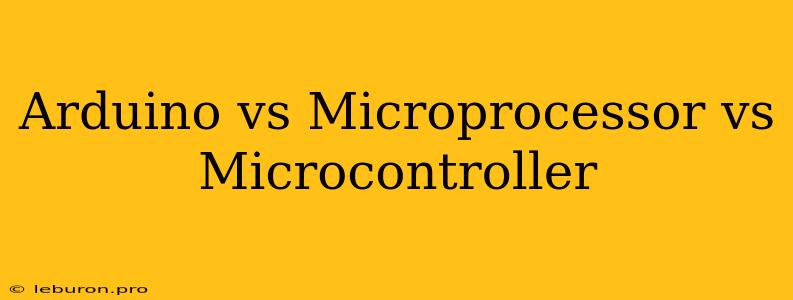The world of embedded systems is a fascinating one, filled with various powerful components that bring life to countless devices around us. Within this world, there's a trio of key players: Arduino, microprocessors, and microcontrollers. While they all contribute to the functionality of electronic devices, understanding their differences is crucial for choosing the right tool for your project. This article aims to shed light on the distinctions between Arduino, microprocessors, and microcontrollers, highlighting their unique features and applications.
Understanding the Basics: Microprocessor vs Microcontroller
Before delving into Arduino, it's essential to grasp the fundamental differences between microprocessors and microcontrollers. Both are integrated circuits (ICs) that process information, but they have key distinctions.
Microprocessor: The Brains of a Computer
Imagine a microprocessor as the central processing unit (CPU) of a computer. It's the "brain" that executes instructions and processes data. It does not include any memory, I/O peripherals, or other components, requiring external components to function. Think of it as a powerful core waiting for instructions from other parts of the system.
Key Features of a Microprocessor:
- High Processing Power: Microprocessors are designed for complex tasks and boast high clock speeds and computational capabilities.
- Flexibility: Their lack of built-in components allows them to be used in various applications with customized configurations.
- External Peripherals: Microprocessors rely on external memory, input/output (I/O) devices, and other peripherals to function.
- Examples: Intel Core i9, ARM Cortex-A series, and Qualcomm Snapdragon processors found in smartphones and computers.
Microcontroller: A Self-Contained System
In contrast, a microcontroller is a complete system on a chip (SoC). It integrates a microprocessor core alongside memory, I/O peripherals, and other supporting components. Think of it as a mini-computer with everything it needs built-in.
Key Features of a Microcontroller:
- Embedded Applications: Microcontrollers are designed for embedded systems, where space and power consumption are critical.
- Built-in Peripherals: They include internal memory (RAM and ROM), analog-to-digital converters (ADCs), digital-to-analog converters (DACs), timers, and other peripherals.
- Low Power Consumption: Microcontrollers are optimized for low-power operation, making them suitable for battery-powered devices.
- Examples: Atmel AVR, PIC microcontrollers, and ARM Cortex-M series found in appliances, automotive systems, and industrial equipment.
Arduino: A Microcontroller Platform
Now, let's focus on Arduino, which is not a microprocessor or a microcontroller itself but a platform based on a microcontroller. Arduino provides an open-source hardware and software platform for building electronics projects. It offers a user-friendly development environment and a wide range of boards, each built around a specific microcontroller.
Arduino's Advantages:
- Accessibility: Arduino is known for its ease of use, with a simple programming language and readily available resources for beginners.
- Community Support: The vast Arduino community provides ample tutorials, examples, and support for diverse projects.
- Versatility: Arduino boards come with various I/O pins, allowing you to connect sensors, actuators, and other components for diverse applications.
- Cost-Effectiveness: Compared to custom microcontroller development, Arduino offers an affordable starting point for experimentation and learning.
Choosing the Right Tool: Arduino vs Microprocessor vs Microcontroller
Now that you understand the key characteristics of each, choosing the right tool depends on your project requirements:
Use a Microprocessor when:
- High processing power is required for demanding tasks like image processing or complex algorithms.
- Flexibility is paramount, and you need to customize the system configuration.
Use a Microcontroller when:
- Embedded applications are the focus, and you need a self-contained system with built-in peripherals.
- Low power consumption is critical for battery-operated devices.
Use Arduino when:
- Learning electronics and programming is your goal, and you appreciate the simplicity and vast community support.
- Rapid prototyping is important, and you need an easy-to-use platform with readily available components.
Conclusion
The choice between Arduino, microprocessors, and microcontrollers ultimately depends on your project's specific needs. Arduino provides an accessible entry point into the world of embedded systems, while microprocessors and microcontrollers offer more specialized solutions for complex applications. Whether you're building a simple home automation system or a sophisticated industrial robot, understanding the differences between these components will help you make the right decision and bring your projects to life.
